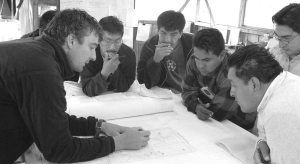DENVER, COLO.–The draft of a new mining law that sets royalties on a sliding scale of 3-8% will be submitted to Ecuador’s legislature in the middle ofOctober, the country’s acting vice-minister of mines, Xavier Cordova, told participants at the Denver Gold Forum in September.
The Ecuadorian government froze mining exploration and revoked most concessions in April. Since then, it has been working on a new mining law designed to strengthen controls over the industry.
“We hope that by mid-October exploration companies can get back to work,” the vice-minister said.
Cordova also noted that an unpopular 70% windfall profits tax was not a part of the proposed new mining code and that his ministry had made a proposal to the Ministry of Revenue to neutralize the tax or eliminate it altogether.
“We would like to either get rid of the windfall profits tax (for mining) or set the threshold so high that it wouldn’t come into effect,” he told mining executives gathered at the forum.
“The (revenue ministry’s) re- sponse (to the suggestion) was positive, that’s my feeling,” Cordova said. “What is missing is the president’s approval. We’re waiting to give our final presentation to the president.”
President Rafael Correa, a left-leaning economist, took office last year and has kept foreign mining companies guessing for the last six months about the future of regulations governing foreign miners in the Andean nation.
Cordova also tried to alleviate fears that a new state-run mining company could take over revoked metal concessions.
“It’s not in our interests to make any nationalizations or take away any concessions,” he assured the gathering. “We want a national mining company that will compete with other mining companies. It will have the same treatment as any of the private mining companies.”
Under the proposed draft law, a sliding-scale royalty of up to 8% will be based on the sales of minerals extracted.
Companies will not be restricted to the number of concessions they may hold, and companies whose concessions were cancelled earlier this year will get the first crack at getting them back, Cordova said.
Under the proposed law, companies will have up to eight years to explore for minerals in concessions and another two years to evaluate the economics of a project before applying for a mining permit. The maximum size of each concession will be five hectares.
Foreign companies will also be expected to contribute to communities and local governments.
Cordova said Ecuador’s mining ministry looked at the mining codes of Peru and Chile as examples.
“We want to have a globally competitive mining industry,” Cordova said. “We want to attract foreign and national companies with the best practices in the industry.”
The question, however, is how much pull mining bureaucrats have in the national government and whether larger political and ideological considerations will conspire against them.
For his part, Tye Burt, president and chief executive of Kinross Gold (K-T, KGC-N), which now owns the massive Fruta del Norte discovery in Ecuador — through its friendly takeover of Aurelian Resources (ARU-T, AUREF-O) — believes their views carry a lot of weight.
Cordova “was extremely supportive of responsible mining in Ecuador and we believe he represents the Ecuadorian government’s views,” Burt said in his corporate presentation to analysts and investors at the gold conference. “By year-end, we think there will be a legislative regime on mining in place.”
Burt added that the Ecuadorian government was “very pleased to have the first major company (Kinross) to come to Ecuador,” and called Fruta del Norte a “cornerstone asset” for the company and the country.
“It’s a small country desperately in need of jobs and revenues,” he said.
Fruta del Norte was discovered in 2006 and has an initial inferred resource of 58.9 million tonnes grading 7.23 grams gold per tonne and 11.8 grams silver for a total of 13.6 million contained ounces gold and 22.3 million contained ounces silver.


Be the first to comment on "Ecuador’s mining reforms nearly complete: official"